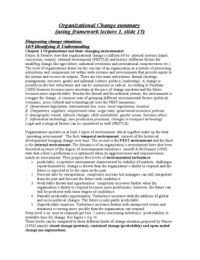Summary
Summary Organizational Change
- Course
- Institution
Complete English summary of all chapters (sequence according framework) Including summary of relevant articles: - Dunphy, D.C. and D.A. Stace (1993). The Strategic Management of Corporate Change. Human Relations, 46: 905 - 920 (15 p.) - Burnes, B. & P. Jackson (2011), Success and Failure In ...
[Show more]



